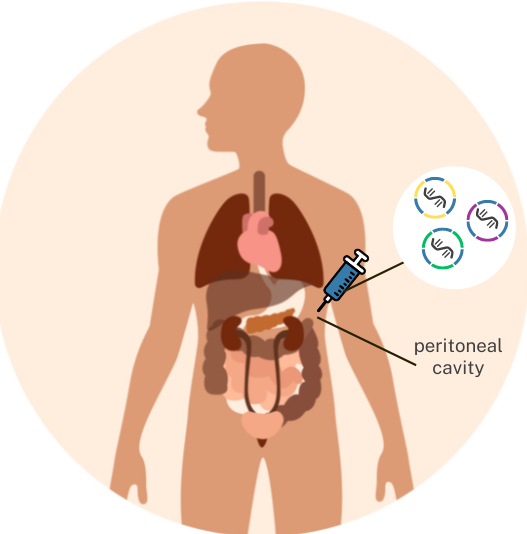Therapeutics that use mRNA—like some of the COVID-19 vaccines—have enormous potential for the prevention and treatment of many diseases. These therapies work by sending mRNA “instructions” to target cells, giving them a blueprint for making specific proteins. These proteins could help tissues regenerate, replace malfunctioning proteins, or trigger an immune response, providing a variety of different treatment strategies.
However, a therapeutic is only useful if it can achieve its objective. The mRNA is typically packaged inside a lipid nanoparticle, which keeps the delicate cargo intact until it reaches its final destination. As the field stands now, mRNA-filled lipid nanoparticles typically reach only a handful of cell types, such as immune cells and those in the liver or spleen. Designing lipid nanoparticles that can target hard-to-reach organs, such as the heart or pancreas, could revolutionize treatment options for a wide range of conditions.
In response to this need, researchers at Carnegie Mellon University are developing lipid nanoparticles designed to deliver mRNA specifically to the pancreas. His study in mice, recently published in Scientific advancescould pave the way for new therapies for intractable pancreatic diseases, such as diabetes and cancer.
“Lipid nanoparticles are essentially little spheres of fat, and fats have all kinds of chemical properties that can affect their ability to travel through the body and target specific organs,” explained Luisa Russell, Ph.D., program director of the Science and Technology Discovery Division at the National Institute of Biomedical Imaging and Bioengineering (NIBIB). “By optimizing these fat molecules and investigating alternative drug delivery routes, the study authors were able to design a lipid nanoparticle that can safely deliver mRNA to pancreatic tissue in mice.”
Current routes of mRNA drug delivery include intramuscular injection (used in COVID-19 vaccines) and intravenous administration (used in some investigational cancer therapies). As a first step toward targeted delivery, the study authors wanted to know if a different administration route could help deliver the mRNA cargo directly to the pancreas. They investigated the delivery of mRNA by intraperitoneal injection, which involves injecting a drug directly into the fluid surrounding organs in the peritoneal cavity (including the kidneys, intestines, and pancreas). “While intraperitoneal injection is not commonly used in humans, this type of administration is used clinically for some difficult-to-treat diseases, such as ovarian cancer,” said study senior author Kathryn Whitehead, Ph.D., a professor at Carnegie Mellon University. “In the case of very severe pancreatic diseases, the benefits of intraperitoneal injection outweigh the risks.”
The researchers packaged mRNA instructions for firefly luciferase (a bioluminescent protein often used in research) into lipid nanoparticles and then injected them into mice intravenously or intraperitoneally. Using bright firefly luciferase to see where the mRNA had traveled, they found that intraperitoneal injection resulted in richer and more specific delivery to the pancreas compared to intravenous injection.
Next, the researchers began to optimize the composition of the fat molecules that make up the nanoparticle. Different fats have unique chemical properties (such as size, electrical charge, and hydrophobicity) that can affect what happens to the nanoparticle once it enters the body. One type of fat molecule used is called an “auxiliary lipid,” so named because it helps stabilize the nanoparticle and improves its potency. The researchers wanted to know if changing the charge of the auxiliary lipid could affect the target of the nanoparticle and direct it toward the pancreas. After testing a variety of different nanoparticle compositions, the researchers found a lipid combination that improved pancreatic targeting in mice.

“In recent years, there has been a much greater appreciation for how lipids in nanoparticles can redirect the delivery of mRNA to different cells and organs,” said the study’s first author, Jilian Melamed, Ph.D., a postdoctoral researcher at the University of Pennsylvania. “The precise ways in which lipid chemistry affects the potency and specificity of nanoparticles are still being discovered, and we are still working to understand how individual lipid components influence overall mRNA delivery.”
When the authors investigated where exactly their optimized nanoparticles went in the pancreas, they were surprised to find that the mRNA was most abundant in the pancreas. islet cellsThey comprise only 1-2% of the total pancreatic tissue. Pancreatic islet cells are responsible for producing hormones that control blood glucose (such as insulin). This specific guidance could have potential downstream clinical applications.
“With further development, our research may lead to the creation of therapies for diabetes or certain types of pancreatic cancer,” Whitehead said. “However, these potential treatments would require more preclinical research before advancing to clinical trials.”
This study was supported by a grant from NIBIB (F32EB029345), along with grants from Eunice Kennedy Shriver National Institute of Child Health and Human Development (NICHD; HD098860) National Science Foundation (NSF) Graduates (DGE1745016).
This Science Highlight describes a basic research finding. Basic research increases our understanding of human behavior and biology, which is critical to promoting new and better ways to prevent, diagnose, and treat diseases. Science is an unpredictable and incremental process: each research advance builds on past discoveries, often in unexpected ways. Most clinical advances would not be possible without knowledge of fundamental basic research.
Study reference: Jilian Melamed et al. Ionizable lipid nanoparticles deliver mRNA to pancreatic β cells via macrophage-mediated gene transfer. Scientific advances (2023). DOI: 10.1126/sciadv.ade1444



